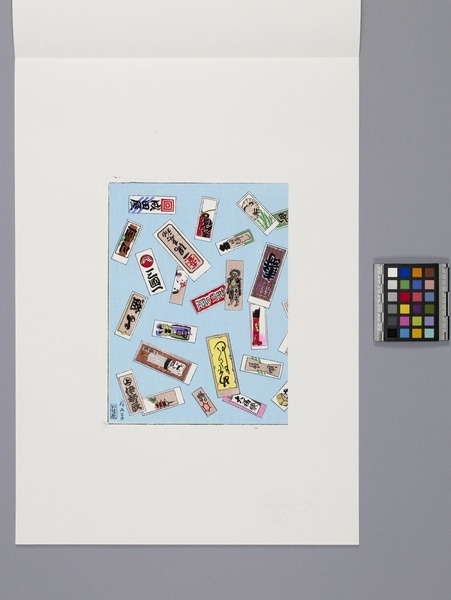Paper Item Number: Ed5.2344 from the MOA: University of British Columbia


Description
Washi sample mounted vertically on white, labelled and folded paper with 3-pointed leaf above scrolled 'm' watermark. Rectangular multi-coloured woodblock print sample. Decorated rectangles in various sizes, overlapping or standing alone in a random pattern on a blue ground with a faint scribble. Decoration varies from script characters, figures or objects with white or white/brown backgrounds. Black outlines white border on top, left and bottom. Paper is folded at top left. Mounting paper folds from top over part of sample.
History Of Use
Papermaking originated on the Asian mainland and spread to Japan by around the 6th or 7th century. For centuries Japan has produced the greatest quantity and variety of handmade paper or washi (和紙). Traditionally, papermaking was a family or community enterprise which thrived in mountain farming communities where cold, pure water and wild bast fibre shrubs, such as mulberry, were plentiful. Washi is an important cultural symbol, as well as a significant aspect of both Shinto and Buddhist rites and customs. Chiyogami (千代紙) was originally produced as woodblock prints, and was likely first made in Kyoto. It was used for writing or poetry paper, for lining incense boxes, or for wrapping cosmetics. It is presently also used for Anesama (姉様) dolls, toys, artificial flowers and greeting cards. Although formerly an expensive luxury item used only by high-ranking individuals, chiyogami later became less expensive, and a popular gift for young women.
Iconographic Meaning
The pattern is called Senjafuda (千社札), representing the wooden calling cards left at shrines by pilgrims.
Specific Techniques
Washi (和紙) sample. Pigment is applied to a cherry wood block, then the paper is applied and rubbed using a baren, a disk-like hand tool used to burnish the back of a sheet of paper in order to lift the ink from the block.
Cultural Context
Chiyogami (千代紙) made in Tokyo is called Edo chiyogami (江戸千代紙) and chiyogami made in Kyoto is known as Kyō chiyogami (京千代紙). This collection features Edo chiyogami by Hirose Tatsugorō IV (広瀬辰五郎四代目), the fourth generation of Isetatsu (いせ辰), a shop established in 1864 in Tokyo (formally known as Edo 江戸), which specializes in Edo chiyogami and Omocha-e (おもちゃ絵/玩具絵) (“play prints”).
Narrative
Part of Vol. V (chiyogami-katazomegami); sample no. 821; from Tesukiwashi Taikan (手漉和紙大鑑) published in Tokyo in 1973–1974, which features a collection of over 900 handmade papers. It was produced as a project to commemorate the centennial of Mainchi Newspapers and to preserve Japanese handmade paper. A collection on this scale had not been made before. This collection consists of 5 boxes of mounted and labelled samples with an explanatory book in 4 of the boxes. The text is in Japanese and with less detail, in English. Compiled and edited by a special editorial staff of scholars. Published by the Mainchi Newspapers, Tokyo, Japan.
Item History
- Made by Tatsugoro IV Hirose (Maker) in Tokyo, Japan between 1973 and 1974
- Collected during 1977
- Owned by Yoshihisa Okamatsu before March 23, 1977
- Received from Yoshihisa Okamatsu (Donor) on March 23, 1977
What
- Name
- Paper
- Identification Number
- Ed5.2344
- Type of Item
- paper
- Overall
- height 51.5 cm, width 36.5 cm
Who
- Culture
- Japanese
- Creator
- Tatsugoro IV Hirose (Maker)
- Previous Owner
- Yoshihisa Okamatsu
- Received from
- Yoshihisa Okamatsu (Donor)
Where
- Holding Institution
- MOA: University of British Columbia
- Made in
- Tokyo, Japan
When
- Creation Date
- between 1973 and 1974
- Collection Date
- during 1977
- Ownership Date
- before March 23, 1977
- Acquisition Date
- on March 23, 1977
Other
- Item Classes
- works on paper
- Condition
- good
- Accession Number
- 0369/0046 n